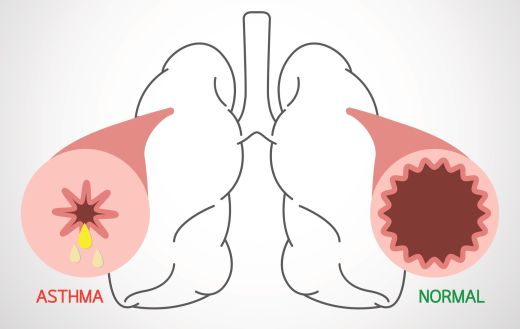Shortness of breath, cough, wheezing: These symptoms are typical of bronchial asthma. This is a chronic disease of the respiratory tract. Which medications are used to treat the disease and what is behind an asthma attack.
Quick overview: Frequently asked questions and answers
What are the symptoms of bronchial asthma? Typical symptoms include a persistent cough, wheezing, shortness of breath and a feeling of tightness in the chest.
What triggers bronchial asthma? Common triggers include allergens such as pollen, animal hair and house dust mites, air pollution, smoke, physical exertion, cold or stress.
Can bronchial asthma be cured? According to current research, asthma cannot be cured. However, with appropriate treatment, most sufferers can lead normal and active lives.
What shouldn’t you do if you have asthma? If possible, avoid contact with known triggers, such as smoking or passive smoking, and extreme physical exertion only with medical advice.
Article contents at a glance:
What is bronchial asthma?
Bronchial asthma is a chronic, inflammatory disease of the airways that occurs in attacks. The bronchi react hypersensitively to harmless stimuli such as cold air with a violent defensive reaction. The bronchial muscles then spasm, the mucous membranes swell and form an excessive amount of tough, glassy mucus. This increases the narrowing of the airways within the lungs (bronchial obstruction).
The breathing air can no longer flow in and out freely, the respiratory muscles are overloaded and shortness of breath occurs.
In Germany, around ten to fifteen percent of children and five to seven percent of adults suffer from asthma.
-

Respiratory system in people with asthma and healthy individuals
© iStock.com/maclifethai
Symptoms: What are signs of asthma?
The symptoms of asthma vary considerably in severity and usually only occur in acute attacks.
During an attack, wheezing, coughing and shortness of breath occur. Breathing and heart rate increase. The shortness of breath is made worse by the fact that breathing out is difficult and takes longer than normal. Due to the persistent dry cough, the glassy, viscous mucus can only be coughed up very sparsely.
The acute asthma attack
An acute asthma attack usually begins with pain behind the breastbone and a dry cough. This is followed by wheezing and shortness of breath. This leads to shortness of breath, which can vary in severity. Breathing out is particularly difficult.
If you have severe shortness of breath, you may also experience a feeling of tightness in the chest and anxiety. An acute asthma attack is usually a frightening situation for those affected.
Different forms of asthma
Some forms of asthma are specifically named according to their triggering cause:
allergic asthma (extrinsic asthma): This form is triggered by allergens and leads to an allergic reaction with increased production of the antibody immunoglobulin E. Allergic asthma often begins in childhood or adolescence.
non-allergic asthma (intrinsic asthma): An asthmatic reaction occurs with immunoglobulin G. The sinuses are almost always chronically inflamed. Typical triggers are external factors such as cold and smoke or stress.
mixed asthma: There are often mixed forms between the allergic and the non-allergic form.
occupational asthma: In some jobs there is daily contact with potential allergens. Examples of this are flour dust allergy in the bakery, contact allergy in hairdressing salons, wood dust allergy in the carpentry shop or reactions to inks and solvents in the printing shop. Symptoms often only appear after years of contact with the trigger.
Infectious asthma: Asthma can be triggered by respiratory infections. Viral infections cause inflammation, which can trigger the typical asthma symptoms or even lead to an asthma attack.
Drug-induced asthma: Some people are hypersensitive to certain medications such as painkillers containing acetylsalicylic acid, non-steroidal anti-inflammatory drugs, anti-inflammatory drugs and beta-blockers. In particularly severe cases, taking it can trigger an asthma attack.
Exercise asthma (exertion asthma): This form mainly occurs at the beginning and after physical exertion. Physical stress increases breathing, which in turn can cool and dry out the bronchial mucous membranes.
Risk factors of asthma
It is not yet clear how bronchial asthma develops. However, there are certain circumstances and conditions that are considered risk factors, especially for allergic asthma. Some factors influence all forms of asthma:
Family stress
Underweight at birth
Allergies, neurodermatitis, cradle cap or eczema in childhood
smoking parents
excessive hygiene
frequent viral respiratory infections
early weaning
Diagnosis when bronchial asthma is suspected
Information obtained from the anamnesis allows conclusions to be drawn about the type and severity of the breathing difficulties. The doctor pays particular attention to the shape of the chest, the breathing rate and signs of a lack of oxygen in the blood.
The stethoscope can be used to listen to the lungs for changes in breathing sounds. By tapping the chest, compaction of the lung tissue and hyperinflation can be detected.
Pulmonary function test and provocation test
Different lung function tests can be used to determine whether the air flow through the narrowed bronchi is disturbed and what type of breathing restriction is present. In asthma, breathing out is particularly difficult. Therefore, the amount of air that patients can breathe out with all their strength and as quickly as possible (exhalation capacity) is particularly meaningful. In addition, the amount of air that remains in the lungs after exhalation (residual volume) is of particular interest.
Inhaling metacholine or histamine artificially provokes a narrowing of the bronchi. In sensitive people, this can also trigger a mild asthma attack.
Stress test and allergy test
By measuring breathing during physical exertion, conclusions can be drawn about whether exercise-induced asthma is present.
To confirm the suspicion of allergic asthma, the amount of antibodies of the immunoglobulin E (IgE) type is determined in the blood. To find the allergy-causing substance, skin tests or blood tests (antibody screening tests, RAST) are carried out.
Therapy: How is asthma treated?
In most cases, bronchial asthma can be easily treated with an asthma spray and enables those affected to live a life with little or no symptoms.
There are different forms of asthma therapy:
Required medication: They treat symptoms of acute asthma attacks and are only used when necessary.
Long-term medication (controller): Here it is taken regularly according to a fixed schedule. Long-term therapy is intended to control chronic inflammation of the airways and prevent attacks in the long term. Long-term medications include inhaled corticosteroids (cortisone), long-acting beta-2 sympathomimetics, leukotriene receptor antagonists and monoclonal antibodies.
Many medications are inhaled, which means the active ingredient reaches the respiratory tract directly. So it is effective even in low doses. There are various inhalation systems that are suitable for inhaling asthma medication.
Accompanying measures in everyday life
In addition to drug treatment, patients can help themselves to go about their everyday life with as little discomfort as possible:
Consistently avoid triggers (pollutants, allergens).
abstain from smoking
regular check-ups with treating doctors
regular exercise and sport
Learn breathing therapy or breathing techniques
Relaxation, for example meditation, Pilates or yoga
Exchange of experiences in self-help groups
Patient training
What is the prognosis for people with asthma?
Although there is no cure for bronchial asthma, it can be controlled to the point where most people can perform at full physical capacity. Early diagnosis is important so as not to risk permanent damage from ongoing inflammation.
The prognosis for childhood asthma in particular is very good: in 30 to 50 percent of cases, the asthma disappears during puberty, but can reappear in adulthood. The more severe the asthma in childhood, the more likely those affected are to continue to suffer from it as adults.
The life expectancy of well-treated asthmatics corresponds to that of healthy people. Untreated asthma, on the other hand, can damage the airways of those affected as the disease progresses and cause permanent breathing problems.

